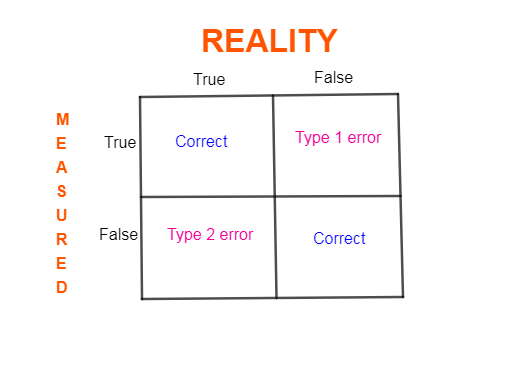
How is a Type 1 error more dangerous than Type 2 error in Statistics?
Answer
437.4k+ views
Hint: We cannot say that Type 1 error is more dangerous than Type 2 error. It depends upon the societies or individuals. For that we are going to first understand what Type 1 and Type 2 errors are in Statistics. Then we will demonstrate through an example that it depends on the societies and individuals whether one error is more dangerous than the other one.
Complete answer:
Type 1 error comes into play when we reject the null hypothesis but in fact it is true. And type 2 error comes into play when rejecting the alternative hypothesis but in fact it is true.
Now, let us understand the terms “null hypothesis” and “alternative hypothesis” using an example. Let the example be that in a courtroom a defendant is innocent. This is the null hypothesis that the defendant is innocent. Then rejecting the null hypothesis (means defendant is guilty) but in reality the defendant is innocent is Type 1 error.
The term “alternative hypothesis” means that we are considering the opposite of the null hypothesis which is that the defendant is guilty. Now, Type 2 error rejects the alternative hypothesis means the defendant is innocent but in fact the defendant is guilty.
Now, generally in societies, Type 1 error is more dangerous than Type 2 error because you are convicting the innocent person. But if you can see then Type 2 error is also dangerous because freeing a guilty can bring more chaos in societies because now the guilty can do more harm to society.
At last, it depends on the frame of individuals or societies which we are taking into consideration to predict whether Type 1 error or Type 2 error is more dangerous.
Note: In the below, we are making a table from which you can easily remember a Type 1 error and Type 2 error. The table is showing that false positive is Type 1 error and true negative is Type 2 error.

Complete answer:
Type 1 error comes into play when we reject the null hypothesis but in fact it is true. And type 2 error comes into play when rejecting the alternative hypothesis but in fact it is true.
Now, let us understand the terms “null hypothesis” and “alternative hypothesis” using an example. Let the example be that in a courtroom a defendant is innocent. This is the null hypothesis that the defendant is innocent. Then rejecting the null hypothesis (means defendant is guilty) but in reality the defendant is innocent is Type 1 error.
The term “alternative hypothesis” means that we are considering the opposite of the null hypothesis which is that the defendant is guilty. Now, Type 2 error rejects the alternative hypothesis means the defendant is innocent but in fact the defendant is guilty.
Now, generally in societies, Type 1 error is more dangerous than Type 2 error because you are convicting the innocent person. But if you can see then Type 2 error is also dangerous because freeing a guilty can bring more chaos in societies because now the guilty can do more harm to society.
At last, it depends on the frame of individuals or societies which we are taking into consideration to predict whether Type 1 error or Type 2 error is more dangerous.
Note: In the below, we are making a table from which you can easily remember a Type 1 error and Type 2 error. The table is showing that false positive is Type 1 error and true negative is Type 2 error.

Recently Updated Pages
Glucose when reduced with HI and red Phosphorus gives class 11 chemistry CBSE

The highest possible oxidation states of Uranium and class 11 chemistry CBSE

Find the value of x if the mode of the following data class 11 maths CBSE

Which of the following can be used in the Friedel Crafts class 11 chemistry CBSE

A sphere of mass 40 kg is attracted by a second sphere class 11 physics CBSE

Statement I Reactivity of aluminium decreases when class 11 chemistry CBSE

Trending doubts
10 examples of friction in our daily life

One Metric ton is equal to kg A 10000 B 1000 C 100 class 11 physics CBSE

Difference Between Prokaryotic Cells and Eukaryotic Cells

State and prove Bernoullis theorem class 11 physics CBSE

What organs are located on the left side of your body class 11 biology CBSE

How many valence electrons does nitrogen have class 11 chemistry CBSE




